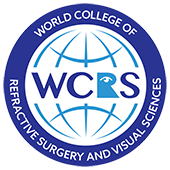What is refractive surgery?
Refractive surgery is a type of surgery that is performed on the eye to correct vision problems caused by refractive errors, such as nearsightedness, farsightedness, and astigmatism. Refractive errors occur when the shape of the eye prevents light from focusing properly on the retina, which is the part of the eye that sends visual signals to the brain.
The goal of the surgery is to reduce or eliminate the need for glasses or contact lenses, and to improve a patient’s overall quality of life. Refractive Surgery is best performed by a surgeon with extensive training and proven expertise in this specialty:
There are three types of refractive surgery:
1. Corneal Based Refractive Surgery
2. Lens Based Refractive Surgery
3. Medical
1. Corneal Based Refractive Surgery
Corneal based refractive surgery is a type of eye surgery that uses lasers or other surgical tools to reshape the cornea, which is the clear, outermost part of the eye. The goal of this surgery is to correct vision problems caused by refractive errors, such as nearsightedness, farsightedness, and astigmatism.
Corneal based refractive surgery is generally considered safe and effective, and can provide significant improvement in vision for many patients. A surgeon who is FWCRS certified in Refractive Surgery can help you determine whether corneal based refractive surgery is a good option for you based on your individual needs and preferences.
There are four types of corneal based refractive surgeries including:
LASIK
LASIK (Laser-Assisted In Situ Keratomileusis) is a type of refractive surgery that is used to correct vision problems caused by refractive errors such as nearsightedness, farsightedness, and astigmatism. LASIK surgery uses a laser to reshape the cornea, which is the clear, outermost part of the eye. LASIK surgery is a quick and relatively painless procedure, usually taking only a few minutes per eye. LASIK surgery is a highly effective way to correct refractive errors and can provide long-lasting improvement in vision for many patients.
However, as with any surgical procedure, there are potential risks and complications that should be carefully considered. A surgeon FWCRS certified in Refractive Surgery can help you determine whether LASIK surgery is a good option for you based on your individual needs and preferences:
Find one here
PRK
PRK (Photorefractive Keratectomy) is a type of corneal-based refractive surgery that is used to correct vision problems caused by refractive errors such as nearsightedness, farsightedness, and astigmatism. Like LASIK, PRK surgery also uses a laser to reshape the cornea, but the procedure is slightly different.
During PRK surgery, the surgeon removes the thin outer layer of the cornea, called the epithelium, using a special brush or laser. Then, an excimer laser is used to reshape the underlying corneal tissue to correct the refractive error. The epithelium will then naturally regenerate over a few days.
PRK surgery is a safe and effective way to correct refractive errors, and can provide long-lasting improvement in vision for many patients. A surgeon FWCRS certified in Refractive Surgery can help you determine whether LASIK surgery is a good option for you based on your individual needs and preferences:
Find one here
SMILE
SMILE (Small Incision Lenticule Extraction) is a type of corneal-based refractive surgery that is used to correct vision problems caused by refractive errors such as nearsightedness. SMILE surgery uses a laser to reshape the cornea, but the procedure is slightly different from LASIK and PRK.
During SMILE surgery, the surgeon creates a small, precise incision in the cornea using a femtosecond laser. This incision creates a thin, disc-shaped layer of corneal tissue called a lenticule, which is then removed through the incision. Removing this tissue reshapes the cornea, correcting the refractive error.
Because SMILE surgery only requires a small incision in the cornea, it may be associated with less postoperative discomfort and a faster recovery time compared to LASIK or PRK surgery. Patients may experience some mild discomfort and blurry vision for a few days after the surgery, but most people are able to return to their normal activities within a week.
SMILE surgery is a safe and effective way to correct nearsightedness, and can provide long-lasting improvement in vision for many patients. A surgeon FWCRS certified in Refractive Surgery can help you determine whether SMILE surgery is a good option for you based on your individual needs and preferences:
Find one here
Presbyopia Corneal Vision Correction (for near vision)
Presbyopia is a common condition that affects people as they age, causing a decreased ability to focus on objects up close. There are several types of corneal refractive surgery options available to correct presbyopia:
- Monovision LASIK: This procedure involves correcting one eye for distance vision and the other eye for near vision. The brain learns to use the appropriate eye for different tasks, allowing for clear vision at different distances.
- Multifocal LASIK: This procedure uses a laser to create multiple focal points on the cornea, allowing for clear vision at different distances without the need for monovision. Some people may experience halos or glare around lights after this procedure.
- Conductive keratoplasty (CK): This procedure uses radiofrequency energy to shrink and reshape the cornea, improving near vision. CK is a minimally invasive procedure that can be performed in a doctor’s office and has a short recovery time.
- Corneal inlays: These are small lenses that are placed in the cornea to improve near vision. Inlays work by increasing the depth of field, allowing for better near vision while still maintaining good distance vision.
It’s important to note that not all corneal refractive surgery options may be suitable for every patient with presbyopia. A surgeon FWCRS certified in Refractive Surgery can help you determine whether presbyopia-correcting corneal refractive surgery is a good option for you based on your individual needs and preferences:
Find one here
2. Lens Based Refractive Surgery
Lens-based refractive surgery is a type of eye surgery that involves replacing the natural lens of the eye with an artificial intraocular lens (IOL) to correct vision problems such as nearsightedness, farsightedness, astigmatism and presbyopia (reading vision).
There are several types of lens-based refractive surgery, including:
- Phakic IOL: This procedure involves implanting an artificial lens in front of the natural lens of the eye to correct refractive errors. This is typically done for patients who are not candidates for LASIK or other types of corneal-based refractive surgery. The EVO Implantable Collamer Lens (ICL) is an example.
- Refractive lens exchange (RLE): This procedure involves removing the natural lens of the eye and replacing it with an artificial IOL to correct vision. This procedure is for patients with nearsightedness, farsightedness, or presbyopia. This procedure is also commonly referred to as a Clear Lens Exchange (CLE) or Custom Lens Replacement (CLR). Advanced lenses are commonly used to give patients a great range of vision from near to intermediate to distance and allows them to get out of glasses for most activities.
Lens-based refractive surgery can provide excellent vision correction and may be a good option for certain patients. However, as with any surgical procedure, there are potential risks and complications that should be carefully considered. A surgeon FWCRS certified in Refractive Surgery can help you determine whether lens based refractive surgery is a good option for you based on your individual needs and preferences:
Find one here
3. Medical
Corneal Crosslinking
Corneal crosslinking is a non-surgical procedure that is used to treat keratoconus, a condition where the cornea of the eye becomes thin and weak, causing it to bulge outwards in a cone-like shape.
The cross-linking process helps to stabilize the cornea and prevent further bulging, which can help to slow or stop the progression of keratoconus. Corneal crosslinking can also be used to treat other conditions that cause corneal thinning, such as corneal ectasia. A surgeon FWCRS certified in Refractive Surgery can help you determine whether corneal crosslinking is a good option for you based on your individual needs and preferences:
Find one here
Presbyopia Drops
Presbyopia is a condition where the natural lens of the eye loses its ability to focus on close-up objects, which typically occurs as people age. One treatment option for presbyopia is the use of prescription eye drops, which work by temporarily relaxing the muscles in the eye that control focus.
Presbyopia eye drops can be a convenient and effective treatment option for certain patients with presbyopia. However, they are not suitable for everyone, and they will not provide a permanent solution to vision correction like Refractive Surgery will. Ask a FWCRS certified refractive surgeon if presbyopia drops are right for you:
Find one here
Myopia Control
Myopia, or nearsightedness, is a condition where the eye is able to focus on objects up close, but has difficulty seeing objects far away. Myopia can often worsen over time, which can increase the risk of developing more serious eye conditions, such as retinal detachment or glaucoma.
Myopia control refers to a range of treatments and strategies that are designed to slow or halt the progression of myopia in children and young adults. Some common approaches to myopia control include:
- Atropine eye drops: Atropine is a medication that is used to dilate the pupils and relax the eye’s focusing mechanism. Low-dose atropine eye drops can be prescribed to help slow the progression of myopia.
- Orthokeratology (ortho-k): Ortho-k involves wearing special rigid contact lenses overnight to reshape the cornea of the eye, which can help to correct myopia and slow its progression.
- Multifocal contact lenses: Multifocal contact lenses are designed to correct both distance and near vision, which can help to reduce the strain on the eye’s focusing mechanism and slow the progression of myopia.
- Behavioral modifications: Certain habits, such as spending more time outdoors, taking frequent breaks when using electronic devices, and maintaining a proper reading distance, can help to reduce the risk of myopia progression.
Myopia control can be an effective way to reduce the risk of more serious eye conditions and improve the long-term health of the eyes. However, not all myopia control strategies are suitable for every patient, and the effectiveness of each approach may vary depending on the individual case. Ask a FWCRS certified refractive surgeon if myopia control is right for you:
Find one here
Dry Eye
Dry eye is a common condition that occurs when the eyes do not produce enough tears or when the tears evaporate too quickly. This can lead to a range of uncomfortable symptoms, such as burning, itching, redness, and sensitivity to light. In addition to these symptoms, dry eye can also cause visual disturbances in the eye.
Common visual disturbances that can be caused by dry eye include:
- Blurred vision: When the surface of the eye is irregular, light entering the eye can become scattered, causing objects to appear blurry.
- Double vision: Dry eye can cause the eyes to become misaligned, which can lead to double vision or ghosting.
- Halos around lights: When the surface of the eye is irregular, light can scatter in different directions, causing halos or glare around lights.
- Fluctuating vision: Dry eye can cause vision to fluctuate throughout the day, depending on how much moisture is present on the surface of the eye.
A FWCRS certified refractive surgeon can help determine if your vision issues are caused by dry eye and recommend treatment options:
Find one here
LATEST NEWS & BLOG
Is It Time for Refractive Surgery to Become Its Own Specialty?
The concept proposed in this article may come across as radical, but, when you consider my reasoning, I think that you can find some sense in its proposition.
Read moreReimagining, Rethinking, and Reinventing Refractive Surgery
We are in the midst of a new renaissance in refractive surgery owing to myriad technology-driven innovations. Refractive surgery is part of the mainstream and accepted by the general public.
Read more

